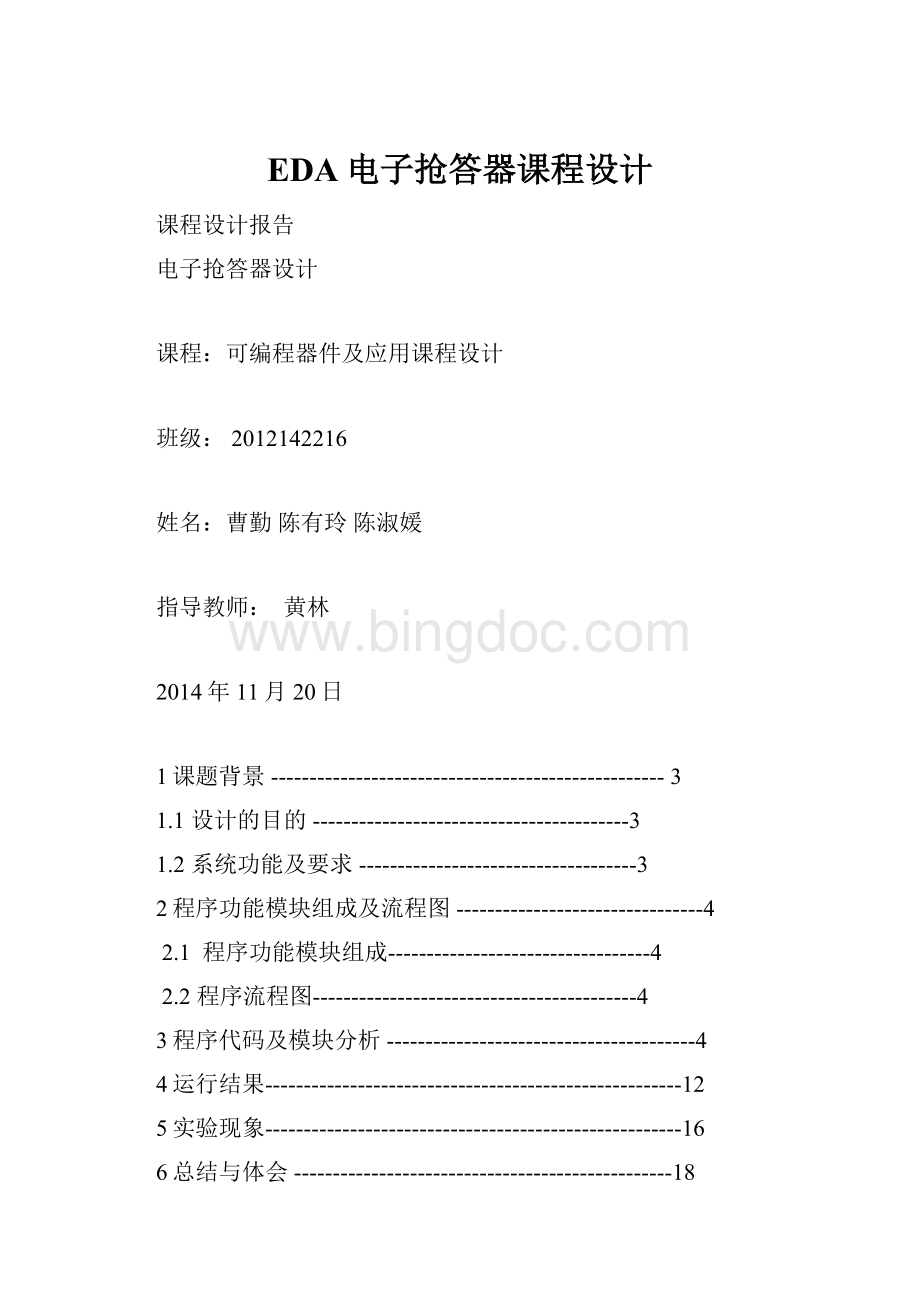EDA电子抢答器课程设计.docx
《EDA电子抢答器课程设计.docx》由会员分享,可在线阅读,更多相关《EDA电子抢答器课程设计.docx(19页珍藏版)》请在冰点文库上搜索。

EDA电子抢答器课程设计
课程设计报告
电子抢答器设计
课程:
可编程器件及应用课程设计
班级:
2012142216
姓名:
曹勤陈有玲陈淑媛
指导教师:
黄林
2014年11月20日
1课题背景---------------------------------------------------3
1.1设计的目的-----------------------------------------3
1.2系统功能及要求------------------------------------3
2程序功能模块组成及流程图--------------------------------4
2.1程序功能模块组成----------------------------------4
2.2程序流程图------------------------------------------4
3程序代码及模块分析----------------------------------------4
4运行结果------------------------------------------------------12
5实验现象------------------------------------------------------16
6总结与体会-------------------------------------------------18
1.课题背景
EDA及电子设计自动化,是指使用计算机自动完成电子系统的设计,应用EDA技术进行电子产品的设计已成为当今电子工程师的一项基本技。
随着电子技术和计算机技术的飞速发展,新的高度集成的电子设计方法不断推出,电子产品的性能越来越高,更新的速度也越来越快,与此同时,市场对电子产品的设计提出了更为严格的要求,从而促进了电子设计自动化(EDA)技术的迅速发展
在多项竞赛及节目上都用到电子抢答器,他们抢答所使用的抢答器就是我这次要做的课程设计的内容。
有了抢答器会使选手间更加公平、公正、公开,也方便了主持人对现场的主持。
1.1设计的目的
本次课程设计的目的是在学习完EDA课程的基础上,运用EDA的知识即VHDL语言,编写程序来实现此次我设计的电子抢答器所要实现的功能,不仅会编写程序,还要能够在实验室中检测我所编写的程序是否能够达到预期的目的。
1.2系统功能及要求
(1)优先编码器电路立即分辨出抢答者编号,并由锁存器进行锁存,然后由译码显示电路显示编号;
(2)扬声器发出短暂声响,提醒主持人注意;
(3)控制电路要对输入编码电路进行封锁,避免其他选手再次进行抢答;(4)当选手将问题回答完毕,主持人操作计分开关,计分电路采用十进制加/减计数器、数码管显示。
本轮抢答完毕,主持人操作控制开关,使系统回复到禁止工作状态,以便进行下一轮抢答。
2.程序功能模块组成及流程图
2.1程序功能模块组成
本程序主要设计了七个模块,分别是:
1.抢答鉴别模块
2.计时模块
3.数据选择模块
4.报警模块
5.译码模块
6.计分模块
7.控制模块
2.2程序流程图
3.程序代码及模块分析
3.1抢答鉴别模块
鉴别锁存模块的关键是准确判断出第一抢答者并将其锁存,实现的方法可使用触发器或锁存器,在得到第一信号后将输入封锁,使其它组的抢答信号无效。
形成第一抢答信号后,用编码、译码及数码显示电路显示第一抢答者的组号并启动答题计时电路。
抢答鉴别电路可以由VHDL程序来实现,以下是一断抢答鉴别的VHDL程序:
libraryieee;
useieee.std_logic_1164.all;
useieee.std_logic_unsigned.all;
entityidentifyis
port(ret,clk:
instd_logic;
a0,a1,a2,a3:
instd_logic;
states:
bufferstd_logic_vector(3downto0);
tmp:
outstd_logic);
endidentify;
architecturebehavofidentifyis
signalst:
std_logic_vector(3downto0);
begin
process(clk,ret,a0,a1,a2,a3)
begin
ifret='1'then
tmp<='0';
st<="0000";
elsifclk'eventandclk='1'then
if(a0='1'orst(0)='1')andnot(st
(1)='1'orst
(2)='1'orst(3)='1')thenst(0)<='1';
endif;
if(a1='1'orst
(1)='1')andnot(st(0)='1'orst
(2)='1'orst(3)='1')thenst
(1)<='1';
endif;
if(a2='1'orst
(2)='1')andnot(st(0)='1'orst
(1)='1'orst(3)='1')thenst
(2)<='1';
endif;
if(a3='1'orst(3)='1')andnot(st(0)='1'orst
(1)='1'orst
(2)='1')thenst(3)<='1';
endif;
tmp<=st(0)orst
(1)orst
(2)orst(3);
endif;
endprocess;
process(states(0),states
(1),states
(2),states(3))
begin
if(st="0000")thenstates<="0000";
elsif(st<="0001")thenstates<="0001";
elsif(st<="0010")thenstates<="0010";
elsif(st<="0100")thenstates<="0011";
elsif(st<="1000")thenstates<="0100";
endif;
endprocess;
endbehav;
3.2计时模块
抢答计时模块的任务是当主持人启动这个计时开关时开始计时,如果在规定的时间内答完题则答题有效,如果在规定的时间内没有完成,则答题无效。
计时器从规定的时间倒计时,计时为零时计时结束。
答题有无效作凭主持人来判断。
计时电路可以由VHDL程序来实现,以下是一段计时的VHDL程序:
libraryieee;
useieee.std_logic_1164.all;
useieee.std_logic_unsigned.all;
entitytimedis
port(clk,ret,sin:
instd_logic;
time1,time2:
bufferstd_logic_vector(3downto0);
warningg:
outstd_logic);
endtimed;
architecturebehavoftimedis
signalco:
std_logic;
begin
process(clk,ret,sin,time1)
begin
ifret='1'then
time1<="0000";
elsifclk'eventandclk1='1'then
co<='0';
ifsin='1'then
iftime1="0000"then
time1<="1001";co<='1';
elsetime1<=time1-1;
endif;
endif;
endif;
endprocess;
process(co,ret,sin,time2)
begin
ifret='1'then
time2<="0010";
elsifco'eventandco='1'then
ifsin='1'then
iftime2="0000"thentime2<="0010";
elsetimee2<=time2-1;
endif;
endif;
endif;
if(time1="0000"andtime2="0000")then
warning<='1';
elsewarning<='0';
endif;
endprocess;
endbehav;
3.3数据选择模块
输入三路信号,上升沿到来时count加一,当count=“00“时,选择in1路信;当count=“01“时,选择in2路信号;当count=“10“时,选择c路信号;等于其他信号时无操作。
数据选择电路可以由VHDL程序来实现,以下是一段数据选择的VHDL程序:
libraryieee;
useieee.std_logic_1164.all;
useieee.std_logic_unsigned.all;
useieee.std_logic_arith.all;
entityselecteis
port(in1,in2,in3:
instd_logic_vector(3downto0);
clk,ret:
instd_logic;
s:
outstd_logic_vector(1downto0);
y:
outstd_logic_vector(3downto0));
endselecte;
architecturebehavofselecteis
signalcount:
std_logic_vector(1downto0);
begin
s<=count;
process(clk,ret)
begin
if(ret='1')thencount<="00";
elsif(clk'eventandclk='1')then
if(count>="10")then
count<="00";
elsecount<=count+1;
endif;
endif;
casecountis
when"00"=>y<=in1;
when"01"=>y<=in2;
when"10"=>y<=in3;
whenothers=>null;
endcase;
endprocess;
endbehav;
3.4报警模块
当输入信号无效或超时时就启动报警模块计。
报警电路可以由VHDL程序来实现,以下是一段报警的VHDL程序:
libraryieee;
useieee.std_logic_1164.all;
useieee.std_logic_unsigned.all;
entityreporteis
port(clk,l:
instd_logic;
q:
outstd_logic);
endreporte;
architecturebehavofreporteis
begin
process(l,clk)
begin
ifl='0'then
q<='0';
elsifl='1'then
q<=clk;
endif;
endprocess;
endbehav;
3.5译码模块
抢答成功后输出选手组号。
译码电路可以由VHDL程序来实现,以下是一段译码的VHDL程序:
libraryieee;
useieee.std_logic_1164.all;
useieee.std_logic_unsigned.all;
entitytranslateis
port(din:
instd_logic_vector(3downto0);
dout:
outstd_logic_vector(6downto0));
endtranslate;
architecturebehavoftranslateis
begin
process(din)
begin
casedinis
when"0000"=>dout<="1111110";--0
when"0001"=>dout<="0110000";--1
when"0010"=>dout<="1101101";--2
when"0011"=>dout<="1111001";--3
when"0100"=>dout<="0110011";--4
when"0101"=>dout<="1011011";--5
when"0110"=>dout<="1011111";--6
when"0111"=>dout<="1110000";--7
when"1000"=>dout<="1111111";--8
when"1001"=>dout<="1111011";--9
whenothers=>dout<="0000000";
endcase;
endprocess;
endbehav;
3.6计分模块
当选手回答完毕后,主持人判断是否正确,酌情加分,若回答正确,加一分,否则不加分,也不减分。
计分电路可以由VHDL程序来实现,以下是一段计分的VHDL程序:
libraryieee;
useieee.std_logic_1164.all;
useieee.std_logic_unsigned.all;
useieee.std_logic_arith.all;
entityjfis
port(q:
inbit;
count:
outstd_logic_vector(3downto0));
endjf;
architecturebehavofjfis
signaltemp:
std_logic_vector(3downto0):
="0000";
begin
process(q)
begin
if(q='1')then
temp<=temp+1;
endif;
endprocess;
count<=temp;
endbehav;
3.7控制模块
输入两路信号a和b,b=‘0’时,将a输出,否则输出‘0’。
控制电路可以由VHDL程序来实现,以下是一段控制的VHDL程序:
ibraryieee;
useieee.std_logic_1164.all;
useieee.std_logic_unsigned.all;
entitymanageis
port(a,b:
instd_logic;
c:
outstd_logic
);
endmanage;
architecturebehavofmanageis
begin
process(b,a)
begin
ifb='1'thenc<='0';
elsifb='0'thenc<=a;
endif;
endprocess;
endbehav;
4.运行结果
1.抢答鉴别模块仿真图
2.计时模块仿真图
3.数据选择模块仿真图
4.报警模块仿真图
5.译码模块仿真图
6.计分模块仿真图
7.控制模块仿真图
4、实验现象
选手组号:
计时显示
.
.
.
.
.
.
6、总结与体会
通过本次试验,掌握了EDA的基本方法,提高了自身的思维水平,增强了动手实践的能力,将可编程器件及运用的知识运用于实践中。
对EDA设计有了很多的领会。
在查阅资料的同时,发现EDA的在社会中得应用非常广泛,涉及到很多生活的各个方面,所以在今后的学习时间里,我们会不断的学习EDA,加强此方面知识的深度,对EDA的要求也要不断提高,不仅仅再局限于书本上的知识。
学好EDA,会对我们在以后的社会及生活有很大的帮助。